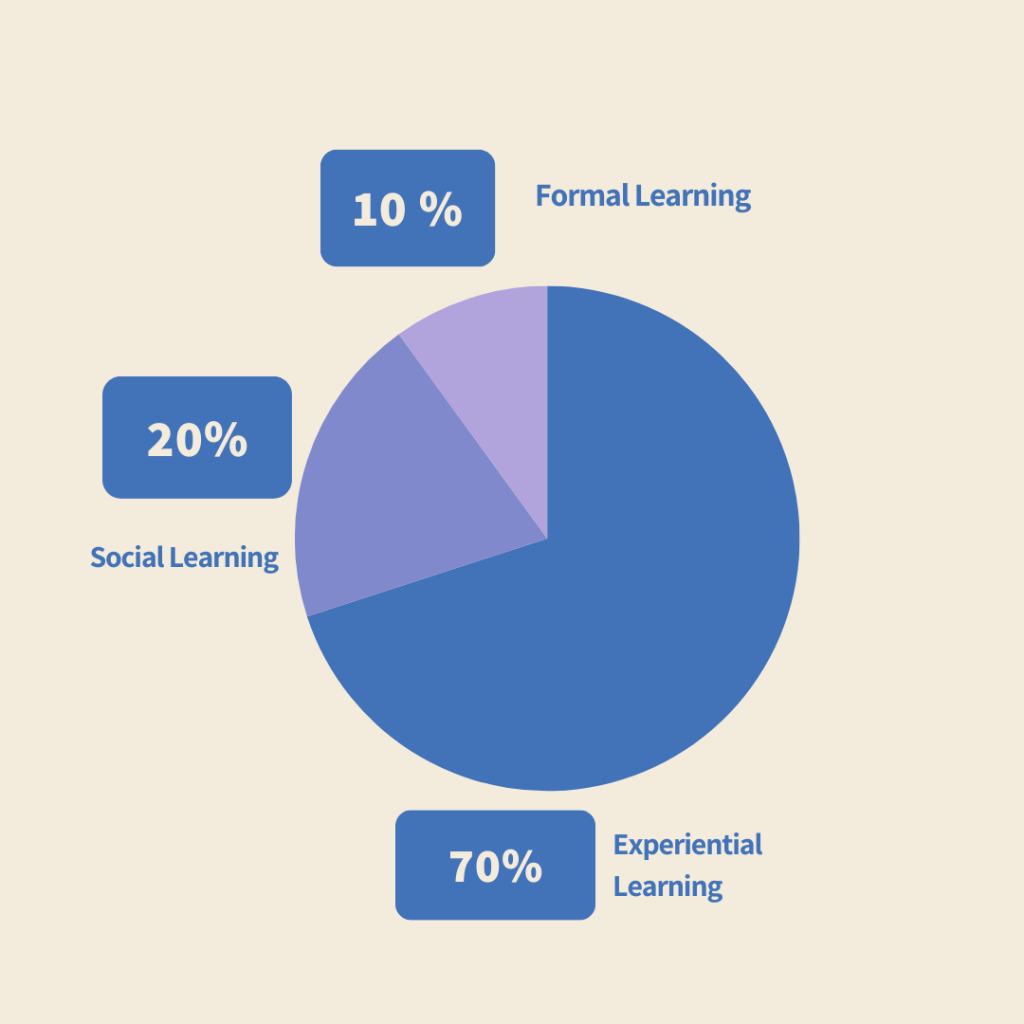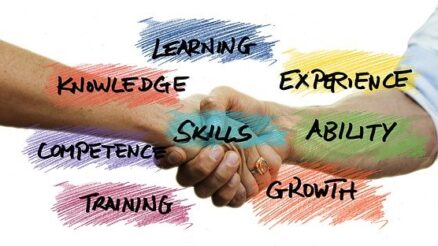Have you ever wondered how people learn best at work?
Enter the 70 20 10 model for learning in the workplace.
It’s crucial for organizations to have effective ways to help employees grow.
The 70 20 10 model breaks down learning into three parts: 70% through hands-on experiences, 20% through social interactions, and 10% through formal training.
Sounds interesting, right?
Join us on this journey as we explore what makes the 70 20 10 model a game-changer for workplace learning.
Let’s dive in and discover how this model can boost skills, teamwork, and success in your organization!
Historical background and development of the 70 20 10 model
The 70 20 10 model for learning in the workplace has its roots in research and observations dating back to the 20th century.
The model’s evolution can be traced to the work of various researchers and theorists who explored how people acquire knowledge and skills in professional settings.
Early Observations
The foundations of the 70 20 10 model were laid through early observations of how individuals learn.
In the 1960s, researchers like Donald Kirkpatrick began to emphasize the importance of on-the-job experiences as a crucial component of learning.
The idea that learning is not limited to formal classroom settings gained traction during this period.
The Center for Creative Leadership (CCL)
The Center for Creative Leadership, a nonprofit institution founded in 1970, played a pivotal role in the development of the 70 20 10 model.
In the 1980s, researchers at CCL, including Morgan McCall, Michael Lombardo, and Robert Eichinger, conducted a study examining successful executives’ developmental experiences.
This study contributed significantly to the concept that a substantial portion of learning occurs through workplace experiences and interactions.
The 70-20-10 Model Takes Shape
The model itself started to take shape in the 1980s and 1990s as a result of the CCL’s research.
The initial formulation suggested that 70% of learning comes from on-the-job experiences, 20% from interactions with others, and 10% from formal education.
While these percentages are not rigid rules, they serve as a guideline to highlight the relative importance of different learning methods.
Further Refinement and Adoption
Over the years, the 70 20 10 model gained popularity in the corporate world as organizations sought more effective ways to develop their employees.
The model’s adaptability and focus on a holistic learning approach resonated with businesses aiming to create agile and skilled workforces.
As a result, many organizations have incorporated the principles of the 70 20 10 model into their training and development strategies.
Today, the 70 20 10 model continues to be a influential framework for designing workplace learning initiatives.
Its historical development underscores a shift from traditional, formal learning paradigms to a more nuanced understanding of how individuals truly acquire and apply knowledge in the professional environment.
What is 70 20 10 Model?
The largest chunk, 70%, is dedicated to experiential learning. This means that most of our learning happens through hands-on experiences and practical tasks.
The 20% represents social learning, acknowledging the significance of interactions with others in the learning process.
The remaining 10% is allocated to formal learning, which includes structured training programs, workshops, courses, and other organized educational initiatives.
In essence, the 70 20 10 model recognizes that effective learning is a holistic blend of hands-on experiences, social interactions, and formal instruction.
This balanced approach is designed to maximize the impact of workplace learning and ensure that individuals not only acquire knowledge but also apply it successfully in their professional roles.
Let’s discuss the three components in detail.

70%: Experiential Learning
Definition
Experiential learning in the workplace refers to the process of acquiring knowledge and skills through hands-on experiences and practical activities.
It emphasizes learning by doing, allowing individuals to actively engage with tasks and challenges in their work environment.
This type of learning encourages employees to directly apply theoretical knowledge to real-world situations, fostering a deeper understanding of concepts and promoting skill development.
How to Leverage On-the-Job Experiences for Skill Development
Leveraging on-the-job experiences for skill development involves intentionally designing work tasks to facilitate learning.
Employers can create an environment that encourages continuous learning by providing challenging assignments, promoting autonomy, and offering opportunities for skill application and experimentation.
Additionally, incorporating mentorship and coaching programs enables employees to learn from experienced colleagues.
Regular feedback and reflection on job performance further enhance the learning process, allowing individuals to identify areas for improvement and refine their skills over time.
Example of Experiential Learning
For instance, a company might highlight how an employee, through a hands-on project, not only gained technical expertise but also developed problem-solving and teamwork skills.
Another example could showcase the impact of job rotations, where employees move through different departments, acquiring a diverse set of skills and a holistic understanding of the business.
These real-world examples serve as evidence that experiential learning not only enhances individual capabilities but also contributes to organizational growth and innovation.
20%: Social Learning
Definition
Social learning in the workplace is a process where individuals acquire knowledge and skills by interacting with others.
It involves collaborative activities, shared experiences, and the exchange of information within a social context.
Significantly, social learning recognizes that people learn not only from formal instruction but also through informal conversations, discussions, and observations.
The workplace serves as a dynamic environment where employees can collectively learn and grow, fostering a sense of community and shared knowledge.
Ways to Foster a Culture of Social Learning within an Organization
Creating a culture of social learning within an organization involves several key strategies. Encouraging open communication and collaboration is essential.
This can be achieved by establishing platforms for discussions, forums, and team meetings where employees can share insights and experiences.
Embracing technology, such as collaboration tools and social media platforms, can facilitate easy information exchange.
Additionally, recognizing and celebrating collective achievements and acknowledging the value of shared knowledge reinforces the importance of social learning in the organizational culture.
Utilizing Mentorship, Coaching, and Peer Collaboration for Skill Enhancement
Mentorship, coaching, and peer collaboration are powerful mechanisms for skill enhancement through social learning.
In a mentorship program, experienced individuals guide less experienced colleagues, sharing their knowledge and providing valuable insights.
Coaching involves one-on-one guidance to help individuals reach specific goals and improve performance.
Peer collaboration encourages employees to work together, leveraging each other’s strengths and learning from diverse perspectives.
These social learning approaches not only enhance individual skills but also contribute to a supportive and knowledge-sharing culture within the organization.
10%: Formal Learning
Definition
Formal learning comprises structured and organized methods designed to impart knowledge and skills in a systematic way.
Workshops, courses, and online training are common examples of formal learning methods. Workshops typically involve hands-on, instructor-led sessions aimed at skill development.
Courses offer in-depth instruction on specific subjects, often with assessments to measure comprehension.
Online training utilizes digital platforms to deliver educational content, allowing flexibility in terms of time and location.
These formal methods provide a structured approach to learning, often following a curriculum or syllabus.
The Role of Formal Learning in Providing Foundational Knowledge and Structured Skills
Formal learning plays a crucial role in providing foundational knowledge and structured skills.
It lays the groundwork by offering a comprehensive understanding of theories, principles, and best practices in a particular field.
This structured approach helps individuals build a solid foundation upon which they can later apply experiential and social learning.
Formal learning methods are particularly effective in introducing new concepts, technologies, or regulations.
They ensure that employees possess the essential knowledge and skills needed to perform their roles competently.
Balancing Formal Learning with Experiential and Social Learning Components
The 70 20 10 model suggests that formal learning should constitute approximately 10% of the overall learning mix.
This balance ensures that theoretical knowledge gained through formal methods is actively applied and reinforced through hands-on experiences (70%) and social interactions (20%).
By combining these different learning approaches, organizations create a holistic learning environment that maximizes skill development, knowledge retention, and the ability to adapt to real-world challenges. This synergy promotes a continuous learning culture within the workplace.
How to Implement 70 20 10 Model for Learning in the Workplace
Implementing the 70 20 10 model in the workplace involves a strategic approach to align organizational learning and development practices with the principles of experiential, social, and formal learning.
Here are strategies for effective implementation:
Assessment of Current Learning Practices
Before implementing the 70 20 10 model, conduct a thorough assessment of existing learning and development practices.
Understand how much emphasis is currently placed on experiential, social, and formal learning. Identify strengths and weaknesses in the current approach to inform the transition to the new model.
Leadership Support and Communication
Gain support from leadership to ensure that the organization is committed to the new learning paradigm. Communicate the benefits of the 70 20 10 model to stakeholders, emphasizing its potential to enhance employee skills, collaboration, and overall performance.
Leadership endorsement is crucial for the success of any significant change in organizational practices.
Customized Learning Paths
Recognize the diverse learning needs of employees and create customized learning paths.
Tailor learning experiences to individual roles, allowing for a mix of experiential, social, and formal learning based on job requirements.
This approach ensures that employees receive relevant and targeted development opportunities.
Integration of Experiential Learning Opportunities
Actively integrate experiential learning opportunities into the daily work routine.
Encourage employees to take on challenging projects, participate in job rotations, and engage in problem-solving activities.
Ensure that the workplace provides a conducive environment for learning by doing, with ample opportunities for skill application and development.
Promotion of Social Learning
Foster a culture of collaboration and knowledge-sharing.
Implement tools and platforms that facilitate social learning, such as discussion forums, mentorship programs, and collaborative projects.
Encourage employees to share insights, seek feedback, and participate in peer learning activities. Recognize and reward collaborative efforts.
Strategic Use of Formal Learning Programs
Design formal learning programs that complement experiential and social learning components.
Offer workshops, courses, and online training that address specific skill gaps or provide foundational knowledge.
Ensure that formal learning is not isolated but integrated into the overall learning journey, reinforcing practical application.
Technology Integration
Leverage technology to support learning initiatives. Use learning management systems (LMS), online platforms, and digital resources to facilitate access to learning materials and enable remote collaboration.
Technology can enhance the efficiency and effectiveness of both formal and social learning components.
Measurement and Feedback Mechanisms
Establish key performance indicators (KPIs) to assess the effectiveness of the 70 20 10 model implementation.
Measure the impact on employee performance, skill development, and overall organizational goals. Collect feedback from employees to continuously refine and improve the learning programs based on real-world experiences.
Continuous Improvement and Adaptability
Embrace a mindset of continuous improvement and adaptability.
Regularly review and update learning strategies based on feedback, changes in the organizational landscape, and emerging learning trends.
Stay responsive to evolving employee needs and technological advancements that can enhance the learning experience.
Training for Managers and Facilitators
Provide training for managers and learning facilitators to equip them with the skills needed to support the 70 20 10 model.
Managers play a crucial role in guiding and mentoring employees through experiential learning, while facilitators ensure that formal learning programs align with organizational objectives.
By implementing these strategies, organizations can successfully transition to the 70 20 10 model, creating a dynamic learning environment that fosters continuous development and adaptation to the evolving demands of the workplace.
Common Misconceptions and Criticisms of 70 20 10 model for learning in the Workplace
Addressing these misconceptions and criticisms requires a nuanced understanding of the model, careful planning, and an appreciation for the unique context and needs of each organization.
It’s essential to view the 70 20 10 model as a flexible framework rather than a rigid prescription.
While the 70 20 10 model has gained popularity as a holistic approach to workplace learning, it is not without its share of misconceptions and criticisms. Here are some common points of contention:
Rigidity of the Percentages
Some people interpret the model as suggesting strict percentages for each learning component (70% experiential, 20% social, 10% formal).
Critics argue that these percentages are not universally applicable and may vary depending on the industry, job roles, and individual learning styles. The model’s intent is to emphasize the importance of a balanced approach rather than imposing fixed ratios.
Lack of Scientific Validation
Some critics argue that the 70 20 10 model lacks solid empirical evidence or scientific validation.
While there is research supporting elements of the model, some argue that the specific percentages may lack a rigorous scientific foundation. The model is more of a guideline than a universally proven formula.
Overemphasis on Informal Learning
The model is sometimes misunderstood as advocating for the exclusion of formal learning.
Critics argue that a complete dismissal of formal learning can be detrimental, especially in industries where regulatory compliance and standardized knowledge are critical.
Ignoring Individual Differences
Critics may suggest that the model overlooks the diversity in individual learning preferences and needs.
Individuals have unique learning styles, and some may thrive more in formal settings while others excel through experiential or social learning. Implementing the model without considering these differences can lead to suboptimal learning outcomes.
Implementation Challenges
Organizations may believe that transitioning to the 70 20 10 model is a straightforward process.
Implementing the model requires a thoughtful and strategic approach. Simply redistributing budgetary allocations without addressing the underlying culture and processes may not yield the desired results.
Lack of Clarity on Definitions
Ambiguity in the definitions of experiential, social, and formal learning may lead to misunderstandings.
Without clear definitions, there’s potential for confusion in how organizations interpret and apply the model. Defining these terms in a way that aligns with organizational objectives is crucial.
Resistance to Change
Employees may resist the shift from traditional learning models.
Change management is a critical aspect of implementing the 70 20 10 model. Resistance can arise if employees are not adequately informed about the rationale and benefits of the new approach.
Lack of Measurement Standards
Some may assume that measuring the effectiveness of the 70 20 10 model is straightforward.
Establishing consistent measurement standards for the diverse components of the model can be challenging. Clear KPIs and assessment methods must be developed for meaningful evaluation.
Final Words
In wrapping up, the 70 20 10 model for learning in the workplace stands out as a powerful guide to help us grow and succeed on the job. By recognizing that most learning comes from doing things (70%), sharing with others (20%), and some formal training (10%), this model gives us a roadmap for building skills and knowledge. It’s like having a balanced recipe for workplace success, blending hands-on experiences, teamwork, and structured learning. So, let’s embrace this approach, fostering a culture where learning is not just a part of the job but a way of thriving in our ever-evolving work environments.



